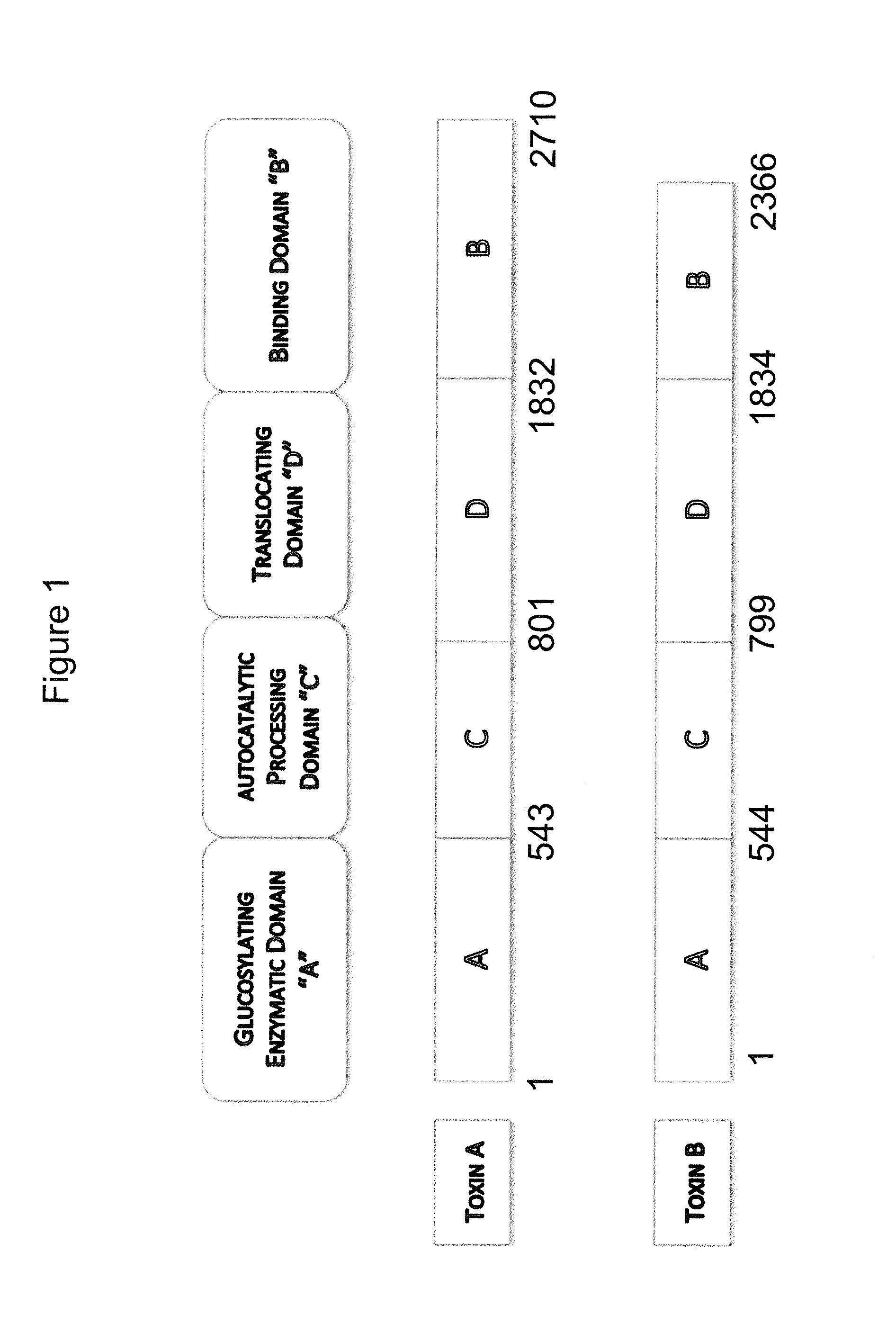Human antibodies to Clostridium difficile toxins
a technology of clostridium difficile and human antibodies, which is applied in the field of human antibodies and antigen-binding fragments, can solve the problems that the recipient of a solid organ transplant may also be at risk for developing a i>c, and achieve the effects of neutralizing the toxicity, reducing the number, duration, or the severity of disease recurren
- Summary
- Abstract
- Description
- Claims
- Application Information
AI Technical Summary
Benefits of technology
Problems solved by technology
Method used
Image
Examples
example 1
Generation of Human Antibodies to Clostridium difficile Toxin A and / or Toxin B
[0241]An immunogen comprising any one of the following can be used to generate antibodies to C. difficile toxin A and / or toxin B. In certain embodiments, the antibodies of the invention are obtained from mice immunized with a primary immunogen, such as a full length, native, inactivated, toxin A (See GenBank accession number CAA63564 (SEQ ID NO: 378)), and / or toxin B (See GenBank accession number CAJ67492 (SEQ ID NO: 380)) from C. difficile, or with a recombinant, but inactivated form of the toxins, or toxin fragments, or a toxoid, followed by immunization with a secondary immunogen, or with an immunogenically active fragment of the native toxin. Animals may be immunized with either inactivated toxin A alone or inactivated toxin B alone, or with both inactivated toxin A and inactivated toxin B, concurrently. The toxins can be inactivated prior to use as an immunogen using standard procedures for preparing ...
example 2
Heavy and Light Chain Variable Region Amino Acid Sequences
[0248]Table 1 sets forth the heavy and light chain variable region amino acid sequence pairs of selected antibodies specific for toxin A and / or toxin B from C. difficile and their corresponding antibody identifiers. Antibodies are typically referred to herein according to the following nomenclature: Fc prefix (e.g. “H4H”, “H1M, “H2M”), followed by a numerical identifier (e.g. “3117” as shown in Table 1), followed by a “P” or “N” suffix. Thus, according to this nomenclature, an antibody may be referred to as, e.g. “H1H3117”. The H4H, H1M, and H2M prefixes on the antibody designations used herein indicate the particular Fc region of the antibody. For example, an “H2M” antibody has a mouse IgG2 Fc, whereas an “H4H” antibody has a human IgG4 Fc. As will be appreciated by a person of ordinary skill in the art, an H1M or H2M antibody can be converted to an H4H antibody, and vice versa, but in any event, the variable domains (includ...
example 3
Variable Gene Utilization Analysis
[0251]To analyze the structure of antibodies produced, the nucleic acids encoding antibody variable regions were cloned and sequenced. From the nucleic acid sequence and predicted amino acid sequence of the antibodies, gene usage was identified for each Heavy Chain Variable Region (HCVR) and Light Chain Variable Region (LCVR). Table 2 sets forth the gene usage for selected antibodies in accordance with the invention.
[0252]
TABLE 2AntibodyIdentifierHCVRLCVRAntibodyHCVR / LCVRVHDHJHVKJKH1H3067N34 / 423-306-6 44-1 4H1H3134N18 / 263-333-1044-1 3H1H3117N 2 / 103-231-7 43-202H1H3123N66 / 743-484-1161-5 1H1H3121N50 / 583-485-1861-5 1H1H3124N82 / 903-483-2261-5 1H1H3328P130 / 1383-133-1061-273H1H3324P 98 / 1063-133-1061-273H1H3325P114 / 1223-233-1061-5 1H1H3330P146 / 1543-331-7 41-395H1H3350P162 / 1703-117-2743-152H1H3347P274 / 2823-231-2641-163H1H3335P194 / 2023-231-2641-163H1H3344P258 / 2663-232-1541-163H1H3339P226 / 2343-231-2641-163H1H3337P210 / 2183-231-2651-163H1H3343P242 / 2503-231-2641...
PUM
| Property | Measurement | Unit |
|---|---|---|
| molecular weight | aaaaa | aaaaa |
| molecular weight | aaaaa | aaaaa |
| equilibrium dissociation constant | aaaaa | aaaaa |
Abstract
Description
Claims
Application Information
 Login to View More
Login to View More - R&D
- Intellectual Property
- Life Sciences
- Materials
- Tech Scout
- Unparalleled Data Quality
- Higher Quality Content
- 60% Fewer Hallucinations
Browse by: Latest US Patents, China's latest patents, Technical Efficacy Thesaurus, Application Domain, Technology Topic, Popular Technical Reports.
© 2025 PatSnap. All rights reserved.Legal|Privacy policy|Modern Slavery Act Transparency Statement|Sitemap|About US| Contact US: help@patsnap.com



